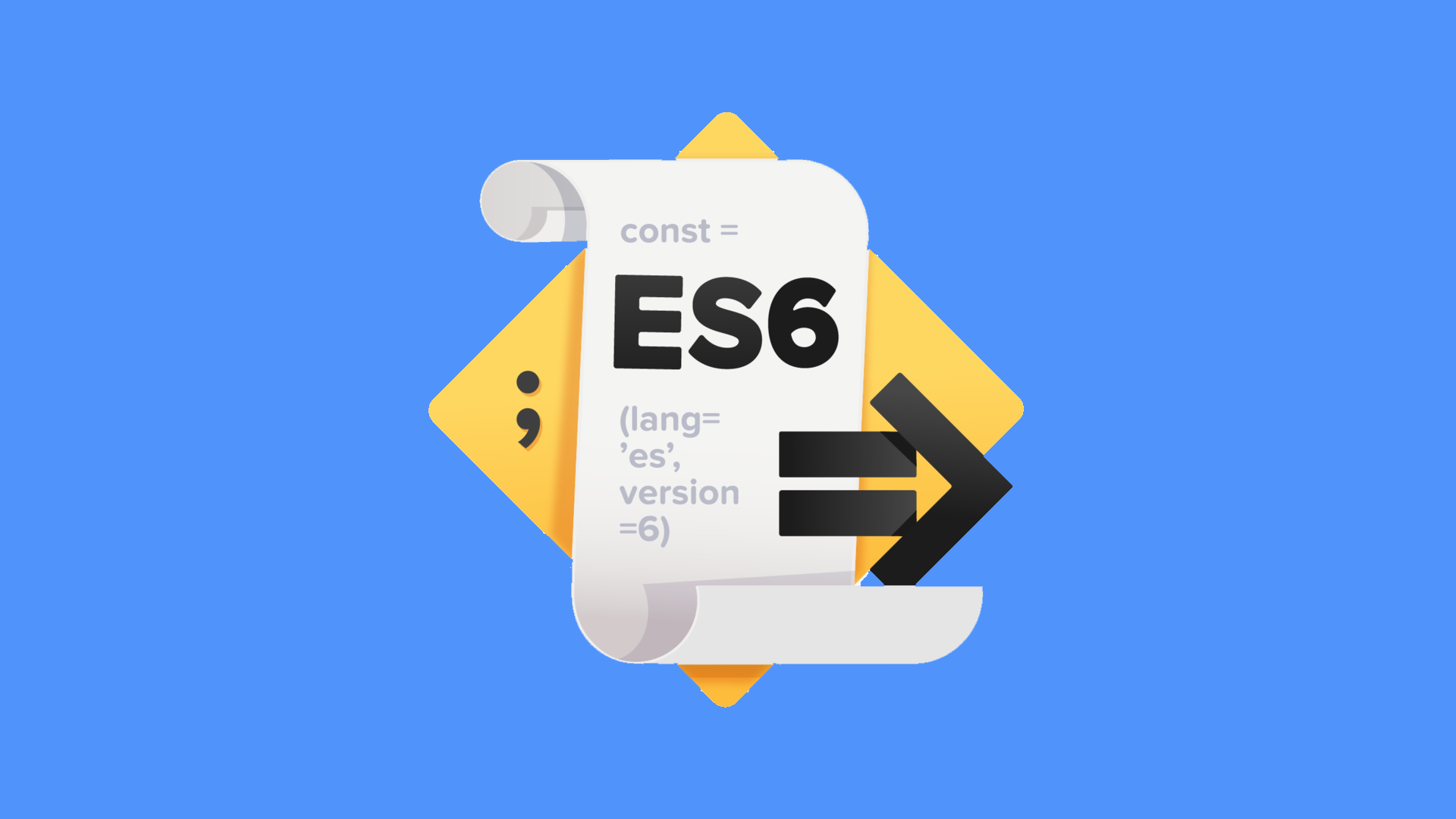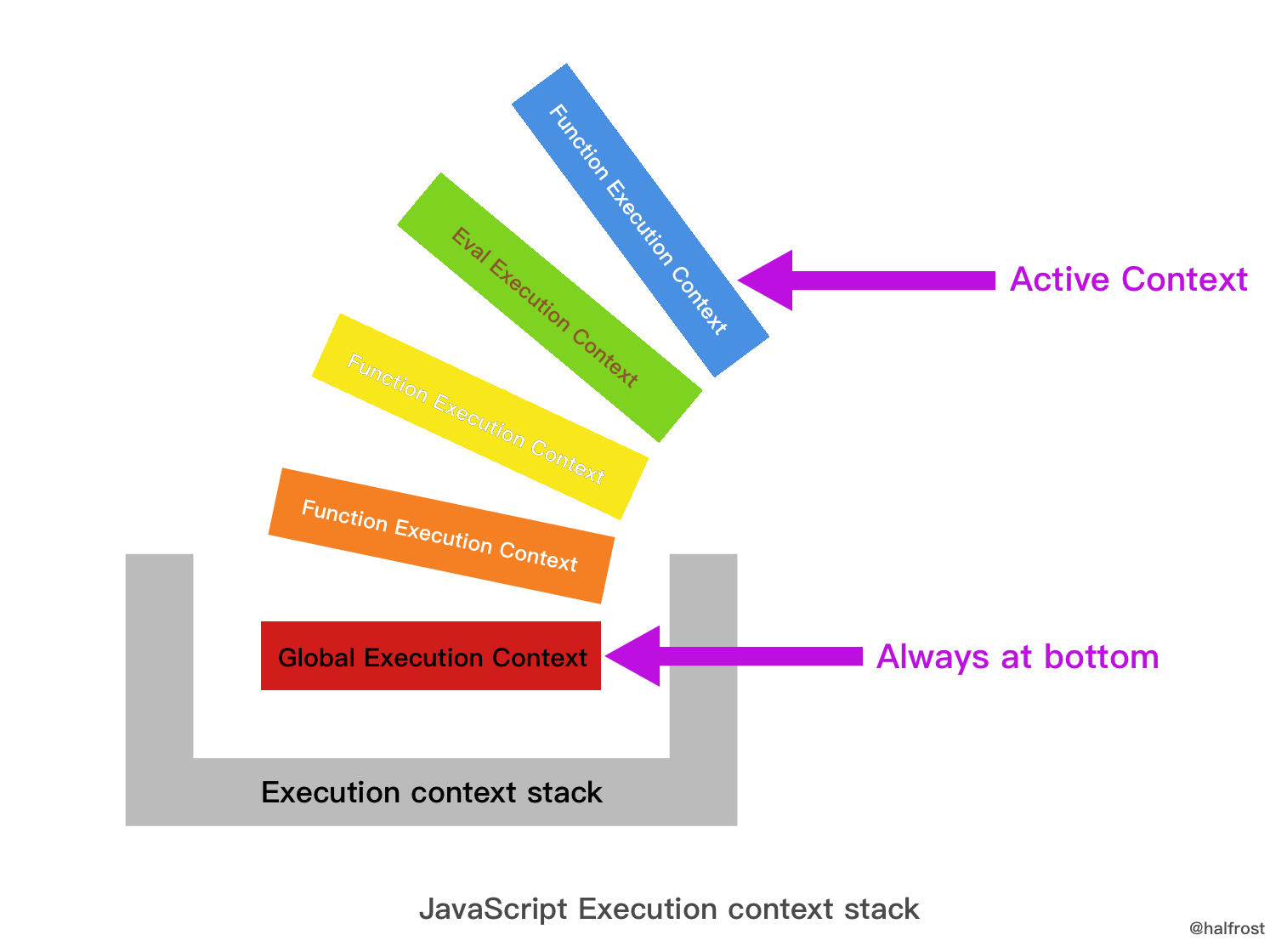
新手在入门 JavaScript 的过程中,一定会踩很多关于 this 的坑,出现问题的本质就是 this 指针的指向和自己想的不一样。笔者在入门学习的过程中,也踩了很多坑,于是便写下本篇文章记录自己“踩坑”历程。
一. this 在哪里?
在上篇 《从 JavaScript 作用域说开去》 分析中,我们知道,在 Execution Context 中有一个属性是 this,这里的 this 就是我们所说的 this 。this 与上下文中可执行代码的类型有直接关系, * this 的值在进入执行上下文时确定,并且在执行上下文运行期间永久不变。 *
this 到底取何值?this 的取值是动态的,是在函数真正被调用执行的时候确定的,函数定义的时候确定不了。因为 this 的取值是执行上下文环境的一部分,每次调用函数,都会产生一个新的执行上下文环境。
所以 this 的作用就是用来指明执行上下文是在哪个上下文中被触发的对象。令人迷惑的地方就在这里,同一个函数,当在不同的上下文进行调用的时候,this 的值就可能会不同。也就是说,this 的值就是函数调用表达式(也就是函数被调用的方式)的 caller。
二. this & that 具体值得是谁?
目前接触的有以下14种情况,笔者打算一一列举出来,以后如果遇到了更多的情况,还会继续增加。
既然 this 是执行上下文确定的,那么从执行上下文的种类进行分类,可以分为3种:

那么接下来我们就从 Global Execution Context 全局执行上下文,Function Execution Context 函数执行上下文,Eval Execution Context Eval执行上下文 这三类,具体谈谈 this 究竟指的是谁。
(一). 全局执行上下文
1. 非严格模式下的函数调用
这是函数的最通常用法,属于全局性调用,因此 this 就代表全局对象 Global。
var name = 'halfrost';
function test() {
console.log(this); // window
console.log(this.name); // halfrost
}
test();
在全局上下文(Global Context)中,this 总是 global object,在浏览器中就是 window 对象。
2. 严格模式下的函数调用
严格模式由 ECMAScript 5.1 引进,用来限制 JavaScript 的一些异常处理,提供更好的安全性和更强壮的错误检查机制。使用严格模式,只需要将 'use strict' 置于函数体的顶部。这样就可以将上下文环境中的 this 转为 undefined。这样执行上下文环境不再是全局对象,与非严格模式刚好相反。
在严格模式下,情况并不是仅仅是 undefined 这么简单,有可能严格模式夹杂着非严格模式。
先看严格模式的情况:
'use strict';
function test() {
console.log(this); //undefined
};
test();
上面的这个情况比较好理解,还有一种情况也是严格模式下的:
function execute() {
'use strict'; // 开启严格模式
function test() {
// 内部函数也是严格模式
console.log(this); // undefined
}
// 在严格模式下调用 test()
// this 在 test() 下是 undefined
test(); // undefined
}
execute();
如果严格模式在外层,那么在执行作用域内部声明的函数,它会继承严格模式。
接下来就看看严格模式和非严格模式混合的情况。
function nonStrict() {
// 非严格模式
console.log(this); // window
}
function strict() {
'use strict';
// 严格模式
console.log(this); // undefined
}
这种情况就比较简单了,各个模式下分别判断就可以了。
(二).函数执行上下文
3. 函数调用
当通过正常的方式调用一个函数的时候,this 的值就会被设置为 global object(浏览器中的 window 对象)。
严格模式和非严格模式的情况和上述全局执行上下文的情况一致,严格模式对应的 undefined ,非严格模式对应的 window 这里就不再赘述了。
4. 方法作为对象的属性被调用
var person = {
name: "halfrost",
func: function () {
console.log(this + ":" + this.name);
}
};
person.func(); // halfrost
在这个例子里面的 this 调用的是函数的调用者 person,所以会输出 person.name 。
当然如果函数的调用者是一个全局对象的话,那么这里的 this 指向又会发生变化。
var name = "YDZ";
var person = {
name: "halfrost",
func: function () {
console.log(this + ":" + this.name);
}
};
temp = person.func;
temp(); // YDZ
在上面这个例子里面,由于函数被赋值到了另一个变量中,并没有作为 person 的一个属性被调用,那么 this 的值就是 window。
上述现象其实可以描述为,“ 从一个类中提取方式时丢失了 this 对象 ”。针对这个现象可以再举一个例子:
var counter = {
count: 0,
inc: function() {
this.count ++;
}
}
var func = counter.inc;
func();
counter.count; // 输出0,会发现func函数根本不起作用
这里我们虽然把 counter.inc 函数提取出来了,但是函数里面的 this 变成了全局对象了,所以 func() 函数执行的结果是 window.count++。然而 window.count 根本不存在,且值是 undefined,对 undefined 操作,得到的结果只能是 NaN。
验证一下,我们打印全局的 count:
count // 输出是 NaN
那么这种情况我们应该如何解决呢?如果就是想提取出一个有用的方法给其他类使用呢?这个时候的正确做法是使用 bind 函数。
var func2 = counter.inc.bind(counter);
func2();
counter.count; // 输出是1,函数生效了!
5. 构造函数的调用
所谓构造函数就是用来 new 对象的函数。严格的来说,所有的函数都可以 new 一个对象,但是有些函数的定义是为了 new 一个对象,而有些函数则不是。另外注意,构造函数的函数名第一个字母大写(规则约定)。例如:Object、Array、Function等。
function person() {
this.name = "halfrost";
this.age = 18;
console.log(this);
}
var ydz = new person(); // person {name: "halfrost", age: 18}
console.log(ydz.name, ydz.age); // halfrost 18
如果是构造函数被调用的话,this 其实指向的是 new 出来的那个对象。
如果不是被当做构造函数调用的话,情况有所区别:
function person() {
this.name = "halfrost";
this.age = 18;
console.log(this);
}
person(); // Window {stop: function, open: function, alert: function, confirm: function, prompt: function…}
如果不是被当做构造函数调用的话,那就变成了普通函数调用的情况,那么这里的 this 就是 window。
构造函数里面如果还定义了 prototype,this 会指向什么呢?
function person() {
this.name = "halfrost";
this.age = 18;
console.log(this);
}
person.prototype.getName = function() {
console.log(this.name); // person {name: "halfrost", age: 18} "halfrost"
}
var ydz = new person(); // person {name: "halfrost", age: 18}
ydz.getName();
在 person.prototype.getName 函数中,this 指向的是 ydz 对象。因此可以通过 this.name 获取 ydz.name 的值。
其实,不仅仅是构造函数的 prototype,即便是在整个原型链中,this 代表的也都是当前对象的值。
6. 内部函数 / 匿名函数 的调用
如果在一个对象的属性是一个方法,这个方法里面又定义了内部函数和匿名函数,那么它们的 this 又是怎么样的呢?
var context = "global";
var test = {
context: "inside",
method: function () {
console.log(this + ":" +this.context);
function f() {
var context = "function";
console.log(this + ":" +this.context);
};
f();
(function(){
var context = "function";
console.log(this + ":" +this.context);
})();
}
};
test.method();
// [object Object]:object
// [object Window]:global
// [object Window]:global
从输出可以看出,内部函数和匿名函数里面的 this 都是指向外面的 window。
7. call() / apply() / bind() 的方式调用
this 本身是不可变的,但是 JavaScript 中提供了 call() / apply() / bind() 三个函数来在函数调用时设置 this 的值。
这三个函数的原型如下:
// Sets obj1 as the value of this inside fun() and calls fun() passing elements of argsArray as its arguments.
fun.apply(obj1 [, argsArray])
// Sets obj1 as the value of this inside fun() and calls fun() passing arg1, arg2, arg3, ... as its arguments.
fun.call(obj1 [, arg1 [, arg2 [,arg3 [, ...]]]])
// Returns the reference to the function fun with this inside fun() bound to obj1 and parameters of fun bound to the parameters specified arg1, arg2, arg3, ....
fun.bind(obj1 [, arg1 [, arg2 [,arg3 [, ...]]]])
在这3个函数里面,this 都是对应的第一个参数。
var rabbit = { name: 'White Rabbit' };
function concatName(string) {
console.log(this === rabbit); // => true
return string + this.name;
}
// 间接调用
concatName.call(rabbit, 'Hello '); // => 'Hello White Rabbit'
concatName.apply(rabbit, ['Bye ']); // => 'Bye White Rabbit'
apply() 和 call() 能够强制改变函数执行时的当前对象,让 this 指向其他对象。apply() 和 call() 的区别在于,apply() 的入参是一个数组,call() 的入参是一个参数列表。
apply() 和 call(),它俩都立即执行了函数,而 bind() 函数返回了一个新的函数,它允许创建预先设置好 this 的函数 ,并可以延后调用。
function multiply(number) {
'use strict';
return this * number;
}
// 创建绑定函数,绑定上下文2
var double = multiply.bind(2);
// 调用间接调用
double(3); // => 6
double(10); // => 20
bind() 函数实质其实是实现了,原始绑定函数共享相同的代码和作用域,但是在执行时拥有不同的上下文环境。
bind() 函数创建了一个永恒的上下文链并不可修改。一个绑定函数即使使用 call() 或者 apply()传入其他不同的上下文环境,也不会更改它之前连接的上下文环境,重新绑定也不会起任何作用。
只有在构造器调用时,绑定函数可以改变上下文,然而这并不是特别推荐的做法。
function getThis() {
'use strict';
return this;
}
var one = getThis.bind(1);
// 绑定函数调用
one(); // => 1
// 使用 .apply() 和 .call() 绑定函数
one.call(2); // => 1
one.apply(2); // => 1
// 重新绑定
one.bind(2)(); // => 1
// 利用构造器方式调用绑定函数
new one(); // => Object
只有 new one() 时可以改变绑定函数的上下文环境,其他类型的调用结果是 this 永远指向 1。
8. setTimeout、setInterval 中的 this
《 javascript 高级程序设计》中写到:“超时调用的代码需要调用 window 对象的 setTimeout 方法”。setTimeout/setInterval 执行的时候,this 默认指向 window 对象,除非手动改变 this 的指向。
var name = 'halfrost';
function Person(){
this.name = 'YDZ';
this.sayName=function(){
console.log(this); // window
console.log(this.name); // halfrost
};
setTimeout(this.sayName, 10);
}
var person=new Person();
上面这个例子如果想改变 this 的指向,可是使用 apply/call 等,也可以使用 that 保存 this。
值得注意的是: setTimeout 中的回调函数在严格模式下也指向 window 而不是 undefined !
'use strict';
function test() {
console.log(this); //window
}
setTimeout(test, 0);
因为 setTimeout 的回调函数如果没有指定的 this ,会做一个隐式的操作,将全局上下文注入进去,不管是在严格还是非严格模式下。
9. DOM event
当一个函数被当作event handler的时候,this会被设置为触发事件的页面元素(element)。
var body = document.getElementsByTagName("body")[0];
body.addEventListener("click", function(){
console.log(this);
});
// <body>…</body>
10. in-line 的方式调用
当代码通过 in-line handler 执行的时候,this 同样指向拥有该 handler 的页面元素。
看下面的代码:
document.write('<button onclick="console.log(this)">Show this</button>');
// <button onclick="console.log(this)">Show this</button>
document.write('<button onclick="(function(){console.log(this);})()">Show this</button>');
// window
在第一行代码中,正如上面 in-line handler 所描述的,this 将指向 "button" 这个 element。但是,对于第二行代码中的匿名函数,是一个上下文无关(context-less)的函数,所以 this 会被默认的设置为 window。
前面我们已经介绍过了 bind 函数,所以,通过下面的修改就能改变上面例子中第二行代码的行为:
document.write('<button onclick="((function(){console.log(this);}).bind(this))()">Show this</button>');
// <button onclick="((function(){console.log(this);}).bind(this))()">Show this</button>
11. this & that
在 JavaScript 中,经常会存在嵌套函数,这是因为函数可以作为参数,并可以在合适的时候通过函数表达式创建。这会引发一些问题,如果一个方法包含一个普通函数,而你又想在后者的内部访问到前者,方法中的 this 会被普通函数的 this 覆盖,比如下面的例子:
var person = {
name: 'halfrost',
friends: [ 'AA', 'BB'],
loop: function() {
'use strict';
this.friends.forEach(
function(friend) { // (1)
console.log(this.name + ' knows ' + friend); // (2)
}
);
}
};
上述这个例子中,假设(1)处的函数想要在(2)这一行访问到 loop 方法里面的 this,该怎么做呢?
如果直接去调用 loop 方法是不行的,会发现报了下面这个错误。
person.loop();
// Uncaught TypeError: Cannot read property 'name' of undefined
因为(1)处的函数拥有自己的 this,是没有办法在里面调用外面一层的 this 的。那怎么办呢?
解决办法有3种:
(1) that = this 我们可以把外层的 this 保存一份,一般会使用 that ,self,me,这些变量名暂存 this。
var person = {
name: 'halfrost',
friends: [ 'AA', 'BB'],
loop: function() {
'use strict';
var that = this;
this.friends.forEach(
function(friend) { // (1)
console.log(that.name + ' knows ' + friend); // (2)
}
);
}
};
person.loop();
// halfrost knows AA
// halfrost knows BB
这样就可以正确的输出想要的答案了。
(2) bind()
借助 bind() 函数,直接给回调函数的 this 绑定一个固定值,即函数的 this:
var person = {
name: 'halfrost',
friends: [ 'AA', 'BB'],
loop: function() {
'use strict';
var that = this;
this.friends.forEach(
function(friend) { // (1)
console.log(this.name + ' knows ' + friend); // (2)
}.bind(this)
);
}
};
person.loop();
// halfrost knows AA
// halfrost knows BB
(3) forEach() 的 thisValue
这种方法特定于 forEach()中,因为在这个方法的回调函数里面提供了第二个参数,我们可以利用这个参数,让它来为我们提供 this:
var person = {
name: 'halfrost',
friends: [ 'AA', 'BB'],
loop: function() {
'use strict';
var that = this;
this.friends.forEach(
function(friend) { // (1)
console.log(this.name + ' knows ' + friend); // (2)
}, this );
}
};
person.loop();
// halfrost knows AA
// halfrost knows BB
12. 箭头函数
箭头函数是 ES6 增加的新用法。
var numbers = [1, 2];
(function() {
var get = () => {
console.log(this === numbers); // => true
return this;
};
console.log(this === numbers); // => true
get(); // => [1, 2]
// 箭头函数使用 .apply() 和 .call()
get.call([0]); // => [1, 2]
get.apply([0]); // => [1, 2]
// Bind
get.bind([0])(); // => [1, 2]
}).call(numbers);
从上面的例子可以看出:
- 箭头函数里面的 this 对象就是定义时候所在的对象,而不是使用时所在的对象。
-
箭头函数不能被用来当做构造函数,于是也不能使用 new 命令。否则会报错 TypeError: get is not a constructor 。
this 指向的固化,并不是因为箭头函数内部有绑定 this 的机制,实际原因是箭头函数根本就没有自己的 this ,导致内部的 this 就是外层代码块的 this。正因为它没有 this,所以也就不能作为构造函数了。
- 箭头函数也不能使用 arguments 对象,因为 arguments 对象在箭头函数体内不存在,如果要使用,可以用 rest 参数代替。同样的,super,new.target 在箭头函数里面也是不存在的。所以,arguments、super、new.target 这3个变量在箭头函数里面都不存在。
-
箭头函数里面也不能使用 yield 命令,因此箭头函数也不能用作 Generator 函数。
-
由于箭头函数没有自己的 this ,当然就不能用 call()、apply()、bind() 这些方法去改变 this 的指向。
13. 函数绑定
虽然在 ES6 中引入了箭头函数可以绑定 this 对象,大大减少了显示绑定 this 对象的写法(call、apply、bind)。鉴于箭头函数有上述说到的4个缺点(不能当做构造函数,不能使用 arguments 对象,不能使用 yield 命令,不能使用call、apply、bind),所以在 ES7 中又提出了函数绑定运算符。用来取代 call、apply、bind 的调用。
函数绑定运算符是并排的双冒号(::),双冒号左边是一个对象,右边是一个函数。该运算符会自动的将左边的对象作为上下文环境(即 this 对象)绑定到右边的函数上。
foo::bar // 等同于 bar.bind(foo)
foo::bar(...arguments) // 等同于 bar.apply(foo,arguments)
(三). Eval执行上下文
14. Eval 函数
Eval 函数比较特殊,this 指向就是当前作用域的对象。
var name = 'halfrost';
var person = {
name: 'YDZ',
getName: function(){
eval("console.log(this.name)");
}
}
person.getName(); // YDZ
var getName=person.getName;
getName(); // halfrost
这里的结果和方法作为对象的属性被调用的结果是一样的。
Reference:
《ECMAScript 6 Primer》
《javascript 高级程序设计》
来自:https://halfrost.com/javascript_this/
扫码二维码 获取免费视频学习资料

- 本文固定链接: http://www.phpxs.com/post/5744/
- 转载请注明:转载必须在正文中标注并保留原文链接
- 扫码: 扫上方二维码获取免费视频资料

